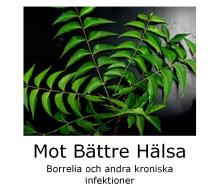De norska forskarna Morten M. Laane och Ivar Mysterud har kommit fram till ett sätt att se bakterier bl.a. från fästinginfektioner i blodet via mikroskop.
”We believe, contrary to the official stance, that the antibody reaction wanes in people who have been sick for a long time, and that only a small minority of those with chronic borreliosis test positive. The Borrelia infection suppresses the immune system so that it does not function properly. This is one of several reasons that it is difficult to give a definite diagnosis.
The tests used today succeed only partly in detecting the disease due to tick bite. Through intensive studies over many years, the two biologists have formed a picture of the life cycle of the Borrelia bacterium and all the different forms that it takes. Borrelia is a thread-like, spiral bacterium, or spirochaete. It can bore into our blood cells and moves around the body with our blood circulation.
As a result, the bacteria spread rapidly and in principle can infect all tissues and organs, including the brain. This is why the symptoms are so many and varied. In the early phase, the symptoms tend to be mild, such as headache, muscular pain and fever. In some cases, however, the disease may last a long time, or become chronic, and the symptoms may vary enormously: stabbing pains, impairments in short-term memory, persistent fatigue, unusually long recovery time after exertion, permanent skin changes, joint pain, paralysis, nervous disorders and depression. One important reason that chronic borreliosis often remains undiagnosed is that the symptoms are not well understood. The diagnosis chronic borreliosis is controversial. The Norwegian health service believes that a four-week course of antibiotics should be enough to kill all Borrelia bacteria in the body, but it is not that simple, according to the two biologists.
”There are strong indications that once the bacterium gets into your bloodstream, it’s there for the rest of your life”, they say.”
Läs hela artikeln här: http://phys.org/news/2013-06-classic-microscopy-reveals-borrelia-bacteria.html#jCp
Här finns studien publicerad: http://www.biomedicalreports.org/index.php?journal=bbr&page=article&op=view&path%5B0%5D=98
Studien har mötts av en del kritik, detta har sagts av forskarna själva:
“Among the arguments presented are that non-helix CWD-forms, small spheres, cysts, “pearl-chain”-like structures, “round-bodies” and filament-like structures are either artifacts from microscopy techniques, protein leakage from blood-cells, fibrine-fibers, or other general changes due to decomposition.”
“It may be argued that the spirochaete-like structures we find are not bacteria based on the findings of numerous biophysical experiments involving erythrocyte blebbing.”
Men visst är det intressant att bilderna de får fram med sin teknik liknar andra forskares bilder av bakterierna i fråga, som enkelt går att googla fram (som t.ex. babesia, bartonella och borrelians specifika spiroketform).
Här hittar Laane t.ex. babesia i blodet på en patient: http://www.youtube.com/watch?v=Qo1J7Jiwb4g
Fler intressanta bilder här: http://fmnytt.me/2013/01/28/ekslusiv-professor-morten-m-laane-og-hans-funn-i-mitt-blod-fyverkeri-borrelia-babesia-bartonella/
Här finns hans hemsida med en kort film: http://www.123hjemmeside.no/Morten-Motzfeldt/19371338
Inslag på norsk tv: http://www.tv2.no/nyheter/innenriks/helse/flaattsyke-nordmenn-kan-ha-blitt-feilbehandlet-i-en-aarrekke-3990023.html
Finns det några svenska forskare som har försökt använda deras metod? Om inte så uppmanar vi er att testa det. Det saknas inte frivilliga personer för ett sånt experiment, det är bara att ni hör av er till oss så fixar vi hur många som helst!




